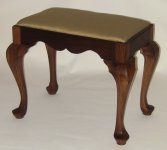Steve Branam
Active member
I'm building a Townsend document chest as part of Al Breed's program for the Guild of NH Woodworkers, Period Furniture Group. This will be a nearly two-year program and series of blog posts:
http://www.closegrain.com/2011/09/building-townsend-document-chest.html
I'm also building Mickey Callahan's Queen Anne foot stool (downloadable from SAPFM site member section plans) for submission to the SAPFM CHS exhibition. The deadline is fast approaching, so this will be a short series of posts:
http://www.closegrain.com/2011/10/building-queen-anne-foot-stool.html
http://www.closegrain.com/2011/09/building-townsend-document-chest.html
I'm also building Mickey Callahan's Queen Anne foot stool (downloadable from SAPFM site member section plans) for submission to the SAPFM CHS exhibition. The deadline is fast approaching, so this will be a short series of posts:
http://www.closegrain.com/2011/10/building-queen-anne-foot-stool.html

